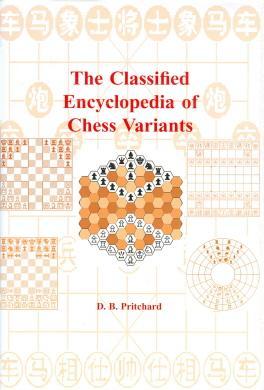
Edward Winter
G.P. Jelliss sends his nicely printed magazine Chessics, which concentrates on fairy chess, chess variants, etc. In the 12th issue (July-December 1981 – Chessics appears twice a year) the contents include problems/studies of Antipodean Chess, Circe Chess, Free Capture Chess with Sensitive Kings and much more. In issue 11 there is an article entitled ‘Honeycomb Leapers’ which begins:
‘The number of cells in a hexagon-shaped board of honeycomb pattern with n cells along each side is 3n(n-1) + 1 as can be visualized by removing the centre cell and cutting the remainder up into three parallelograms each n-1 cells.’
That we failed to understand much of the magazine is more an indication of our own limitations rather than a criticism of the contents. Anyone with a liking for chess variants, plus a good imaginative streak and a drop of science to his name is likely to find Chessics entertaining and addictive.
(278)
David Pritchard (Godalming, England) is compiling an encyclopaedia of chess variants (all games related to chess, and notably those either derived from or inspired by it). For each variant (and to date Mr Pritchard has recorded nearly 500), the book will aim to feature the origins/history, rules, game-scores, problems, anecdotes, etc. Anyone able to provide information, including advice on obscure sources should contact our correspondent.
(1793)
Published at the end of 1994 by Games & Puzzles: The Encyclopedia of Chess Variants by D.B. Pritchard. In a 384-page hardback the author offers alphabetically-organized entries on an astonishing array of games deviating from the ‘normal’ chess rules. What a pleasure to see a writer showing such mastery of a broad field.
(2078)

The Classified Encyclopedia of Chess Variants by D.B. Pritchard (Harpenden, 2007) is an updated edition of his 1994 volume The Encyclopedia of Chess Variants, having been ‘completed and edited by John Beasley’. We had extensive correspondence with the late David Pritchard as he prepared, over many years, his 1994 volume, and John Beasley justly notes on page 15 of the new Variants book that D.B.P. ‘stood head and shoulders above anyone else in this field’. For his part, Mr Beasley has carried out the editorial work in fine style, making this one of the best recent chess books.
(5106)
Variant Chess, a magazine which appears four times a year, provides an imaginative range of unorthodox games and problems. From the January-March 1993 issue we cull a specimen of Italian Progressive Chess, in which White and Black take turns to make an ascending number of moves:
G. Buccoliero – P. Novak
Italy v United Kingdom correspondence match, 1991
1 d4
2 c5 Nf6
3 e4 e5 exf6
4 d5 Bg4 Bxd1 gxf6
5 Nf3 Ne5 Nd7 Bb5 Nxf6 mate.
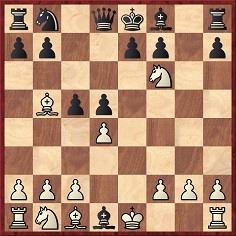
The next game is an example of Vinciperdi, or Losing Chess, which has its own opening theory and grading list. Check does not exist, and the king can be captured.
R. Magari (Italy) – P. Yearout (USA)
Heterodox Chess Olympiad (a correspondence event, 1989-92)
1 e3 b5 2 Bxb5 Nf6 3 Bxd7 Bxd7 4 c4 Bb5 5 cxb5 Qxd2 6 Qxd2 Nc6 7 bxc6 Nd5 8 Qxd5 Kd7 9 Qxf7 Kxc6 10 Qxg7 Bxg7 11 b4 Bxa1 12 b5 Kxb5 13 a4 Kxa4 14 Bb2 Bxb2
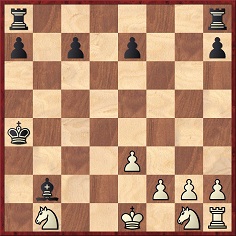
15 Nc3 Bxc3 16 h3 Bxe1 17 Ne2 Bxf2 18 Rd1 Bxe3 19 Nf4 Bxf4 20 g3 Bxg3 21 h4 Bxh4 22 Re1 Bxe1. White wins.
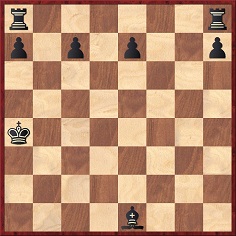
Variant Chess is edited by Peter Wood (Hastings, England).
(1993)
From page 3 of the New York Saturday Press, 18 December 1858:
‘... If anybody attempts to introduce a great chess reform, based upon experience or study, treat it with sneers and jeers. It is not your business of course to expend money in procuring articles and books upon the subject, and you will find that bad jests and ungrammatical ridicule are cheap substitutes for sound thought and cool argument.’
See Advice for Chess Journalists.
From page 32 of CHESS, November 1948:
‘According to an announcement by Grob, Bogoljubow has invented a new game of “movement”, using chessmen and the chessboard. The whole game lasts at most 35 moves.’
Wanted: more details.
(3781)
C.N. 12158 commented that no progress had been made on this matter.
From an article entitled ‘Glimpses of Alekhine’ by M.E. Goldstein on pages 86-87 of Chess World, 1 May 1946:
‘... Until well into the small hours of the mornings [in Scarborough, 1926], Alekhine, Bogoljubow, Colle, Sir George Thomas and myself used to play “Two-Move Chess”. In this fantastic form of the game, a player is permitted to make two moves at a time, provided he does not check on the first move.
Alekhine proved a past-master in this game also; his ability to check on the second move and thus restrict his opponent’s choice was one reason for his superiority over the other players.’
C.N. 3964 mentioned that Alekhine also won a Kriegspiel tournament while in Scarborough.
(3981)
A curiosity about Alekhine and Neo-Chess from page 7 of the San Francisco Examiner, 29 February 1924:
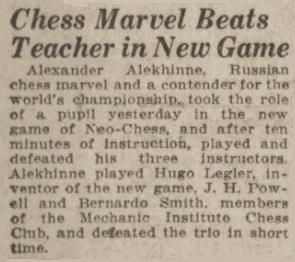
(10998)
Our Earliest Occurrences of Chess Terms article has two 1942 references to ‘Blitz’, and now Grall Gwénolé (Douarnenez, France) draws attention to a slightly earlier mention of ‘Blitz-krieg chess’, in the Catalog of Copyright Entries of the Library of Congress (available at Google Books):

We add this advertisement from page 210 of the December 1940 Chess Review:

One error we are tired of seeing constantly repeated concerns Capablanca’s suggestion of modifying the rules of chess, and once again we feel that behind the inaccuracy is a desire to mock an immortal figure. A recent repetition is on page 94 of Soltis’s Lists book: ‘... after he lost the world title in 1927 Capablanca came up with his own version of an improved game of chess’. The implication is clear: Capa was happy enough with the normal mode of play so long as he was champion but not once Alekhine had defeated him.
This is wholly untrue. Capablanca published an article in the Revista Bimestre Cubana, March-April 1926 (reprinted in Homenaje...) in which he suggested an additional form of chess to exist alongside the ‘real’ game, with a 10x10 board, two extra pawns and new pieces per side and the option for the former to advance one, two or three squares on their first move. Note the year: 1926.
(983)
A number of predictions, successful or otherwise, have been quoted over the years. Below is an extreme example of the ‘otherwise’ category, from page 334 of Shakhmatny listok, November 1925:
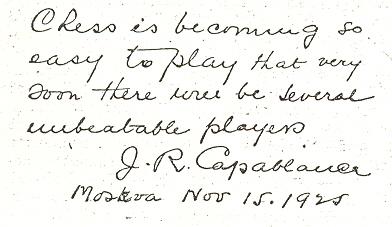
(4228)
‘Schach in seiner gegenwärtigen Gestalt wird bald den Tod des Remis erleiden’, wrote Emanuel Lasker in his booklet Mein Wettkampf mit Capablanca (see pages 32-33 of the 1926 edition). The English translation on page 249 of the July 1921 BCM was: ‘Chess in its present form will die the death of the draw.’
For some comments by Capablanca, made while he was still world champion, see Capablanca on Moscow, 1925, as well as C.N. 4228. The latter item reproduced a remark by him written on 15 November 1925:
‘Chess is becoming so easy to play that very soon there will be several unbeatable players.’
It may be wondered when the Cuban first formed such a view, and one oddity, currently inexplicable to us, is a letter from C.Y.C. Dawbarn of Liverpool on pages 184-185 of the May 1922 BCM. It began:
‘In the course of his match with Dr Lasker, Señor Capablanca hazarded the opinion that chess was in fact exhausted; that, as in billiards or croquet, other reasons rather than the game itself determined the issue ...’
For his part, Capablanca stated a couple of months later:
‘I have been quoted as saying that chess has reached its limit. I never said anything of the kind. Somebody else made some such remark, and even he was misquoted.’
Source: The Times, 19 July 1922, page 15.
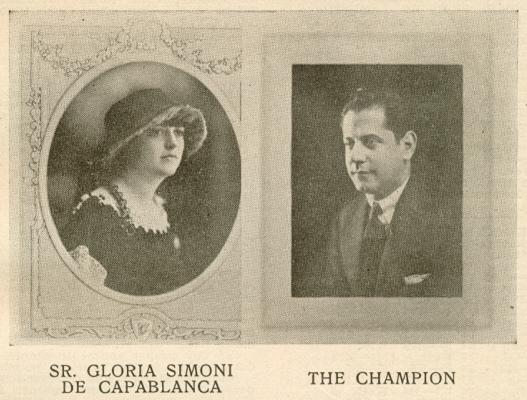
Illustration on page 177 of the December 1922 American Chess Bulletin
(5437)
Jon D’Souza-Eva (Oxford, England) asks which configurations Capablanca advocated for a different form of chess. We give below three quotes from the Cuban’s writings which appeared in our book on him:
‘To make only the changes that are necessary, I have suggested that instead of 64 squares there should be 100, i.e. a 10x10 board instead of 8x8. There would thus be two extra pawns and two more major pieces behind them. To complete the range of moves, one of the pieces would have the combined moves of the bishop and knight, and the other those of the rook and knight. One would be placed on the queen’s side, the other on the king’s side. Instead of having the option of moving one or two steps, pawns would be able to move one, two or three.
The remaining rules would stay the same.’
Source: Article on Moscow, 1925 in Revista Bimestre Cubana, Volume XXI, Number 2, March-April 1926.
‘Personally, I am in favor of the 100-square board, 10 by 10, with two new pieces for each side, the one to have the powers of the rook and knight, and the other the powers of the bishop and knight. Where exactly these pieces should stand at the start can be settled later, though I suggest one each next to the king and queen; and there would be another minor change to consider, in giving permission for the pawns to move one, two or three squares on the first move, in order to bring the opposing sides more quickly in touch with one another. The broad principle is the 100-square board, which I prefer to the 80-square board, 10 by 8, and the new pieces.’
Source: Letter to The Times (London), 24 November 1928, page 13.
‘My own suggestions involve the introduction of new pieces upon the board: the Chancellor, combining the moves of the bishop and knight; and the Marshall [sic], combining the moves of the rook and the knight. This means to say that the Chancellor may be used either as a bishop or as a knight for any move according to the will of the player, while the Marshall in the same way can be used as a rook or knight. The latter piece, I think, would prove the stronger in an endgame. The introduction of these two pieces would of course mean a 100-squares board and two extra pieces on each side. But it would not entail any alteration of the rules.’
Source: Interview/article entitled ‘Brighter Chess’ on pages 44-45 of the Chess Amateur, November 1929.
Our monograph also quoted Edward Lasker on pages 427-428 of Chess
Secrets I Learned from the Masters (New York, 1951) and on
page 263 of the April 1974 Chess Life & Review. He
indicated that in later years Capablanca came to prefer a 10x8
board, but we recall no writings to that effect by the Cuban or,
indeed, anything published by him on ‘changing the rules’ after
the 1920s. [See, however, C.N. 11861 below.]
There is an excellent entry for Capablanca Chess on pages 38-40 of The Encyclopedia of Chess Variants by David Pritchard (Godalming, 1994).
(5618)
From Yasser Seirawan (Amsterdam):
‘I love the powers of the two new pieces introduced by Capablanca but strongly dislike the names that he assigned to them: Chancellor and Marshall/Marshal. What imagery comes to mind with those names, and how could such images be converted into pieces for the chess board? What would they look like? Nor do I like the 10x10, or even the 10x8, board.
That is why Bruce Harper and I created a new chess variant. We renamed the Marshall/Marshal an Elephant (having the powers of the rook and knight) and the Chancellor a Hawk (with the powers of the bishop and knight).
The “novelty” lies in the way these new pieces are introduced into play, on an 8x8 chess board. At the start of the game they are out of play, and they do not appear on the board until there is a vacant square on the player’s back rank. Thus each player has a maximum of eight opportunities to bring in the two new pieces. They may be introduced on any move when one of the original pieces moves from the back rank. For instance, the opening move 1 Nf3 vacates the g1 square, and White would have three options: a) 1 Nf3, b) 1 Nf3/Hg1, and c) 1 Nf3/Eg1.
A practical example: 1 d4 d6 2 e4 e5 3 dxe5 dxe5 4 Qxd8/Ed1 mate.’
For more details, see the webpage Seirawan Chess.
(5622)
Yasser Seirawan (St Louis, MO, USA) writes:
‘Both Bruce Harper and I take pride in “adapting” Capablanca’s pieces to the 8 x 8 board with the creation of “S-Chess”, as opposed to Capa’s suggestion for a 10 x 10 board. Is it possible that others before us also tried to “improve” on Capa’s variant? Did any of the proposals try to make Capa’s new pieces “fit” on an 8 x 8 board?’
(11965)
Joose Norri (Helsinki) notes a webpage of the British Chess Problem Society [broken link] with an impressive survey by T.R. Dawson of ‘new’ pieces introduced over the centuries. See, in particular, the reference to Carrera’s insertion in 1617 of two new pieces, the campione and centaur, on a 10x8 board.
(5626)
Mark McCullagh (Belfast, Northern Ireland) points out a proposal by Horatio Bolton in a letter published on page 318 of the Chess Player’s Chronicle, 1852:
‘A new specimen of odds which, so far as I know, originates with myself, has been lately patronized here, and I wish for your judgment as to the relative strength of the parties.
The first player alone agrees not to check his adversary until he can effect checkmate; in every other respect the game is played as usual on both sides. These odds, I believe, are equal to giving a queen, and they occasion very striking positions.’
(5629)
An excerpt from an interview with Alekhine by Isaac Kashdan on pages 9-10 of the September 1933 Chess Review:
‘Particularly in Asia I was interested in the number of different peoples that play chess, and also in the varieties of the game itself. It is there that chess probably originated. I found several simple forms, and others even more complicated than the game we know. It may be, in time, that we can combine the best features of the Oriental game with our chess. This would be a more natural evolution than adding new pieces and squares, or some of the other changes that have been proposed. I do not believe that chess needs any change at present, as it still holds new wonders, and will continue to do so for years to come.’
(5631)
The chapter ‘Changing the Rules’ in our book on Capablanca has been supplemented by C.N.s 5437, 5618 and 5619, but more needs to be discovered about the earliest occasions when the Cuban advocated modifications. There is, for instance, this quote from an unspecified interview:

Source: Deutsche Schachzeitung, June 1921, page 143.
(6838)
In the chapter entitled ‘Changing the Rules’ page 176 of our book on Capablanca remarked that commentators have ‘repeatedly claimed – often with a sneer – that the suggested innovations came only after Capablanca’s match loss to Alekhine in 1927’.
The following page gave an English translation of Capablanca’s article ‘Chess Requires Modifications’ in the July 1928 issue of Revista Cubana de Ajedrez, pages 13-14. It included this passage:
‘Seven years ago, following my match with Lasker, I wrote that if the same form of methodical research and scientific progress continued, chess would be played out within a relatively short period, which I then set as a maximum of 50 years; two or three years later I again wrote on the same subject, indicating a period of only 25 years before such a state of affairs would be reached. If scientific research continues in the same way I believe today that with not more than ten years chess will be if not completely played out at least virtually so as regards contests between the world’s top half-dozen players; that is to say, I do not believe that ten years will pass without there being half a dozen players who can, when they so wish, draw virtually at will. If out of ten games they perhaps win one, it will be more by accident than anything else.’
Pages 181-182 of our book reproduced from the November 1929 Chess Amateur (pages 44-45) an article/interview with the Cuban (‘Brighter Chess’) which began:
‘It was immediately after my contest at Havana with Dr Lasker, in which I won the chess championship of the world, that I first put forward my suggestions for changes in the game of chess. The reasons for my proposals were obvious. For some time there had been a growing feeling among the general public that championship chess is a very dull pastime, giving too little scope to the imagination and to the creative power of the individual player.’
The Chess Amateur did not specify that the article had already appeared elsewhere, but it had been published on page 10 of the Straits Times [broken link], 11 October 1929 (‘Straits Times Copyright – Reproduction Rights Reserved’). Whether Capablanca’s text was indeed first printed in Singapore is unknown.
Nor is it yet possible to say what, and where, he wrote on the subject in 1921, although, as reported in C.N. 6838, on page 143 of the June 1921 Deutsche Schachzeitung Tartakower referred to an interview given by the new world champion:

Capablanca contributed a lengthy letter to the London Times, 24 November 1928, page 13. It was reproduced on pages 178-180 of our book, together with, on pages 180-181, a letter from Emanuel Lasker (on page 14 of the Manchester Guardian, 31 December 1928) strongly criticizing the proposals (‘cheap and inartistic’):

Earlier that month (on page 6 of the 15 December 1928 edition of the Manchester Guardian) Max Euwe had written as follows:
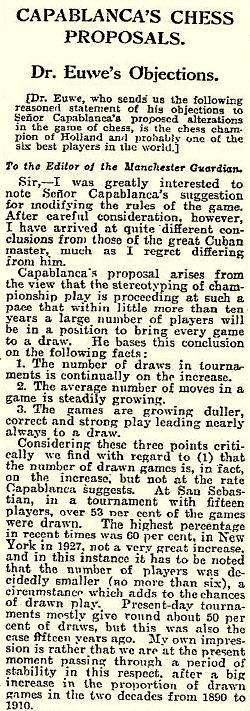
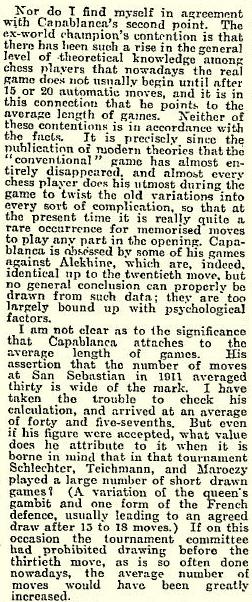
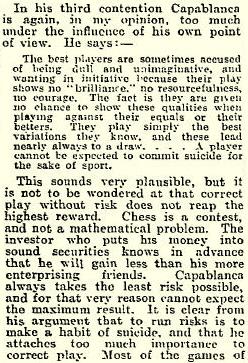
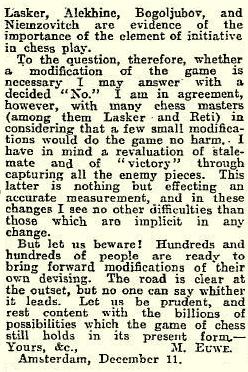
Finally, below is a letter which Tarrasch contributed on page 20 of the 18 January 1929 edition of the Manchester Guardian:

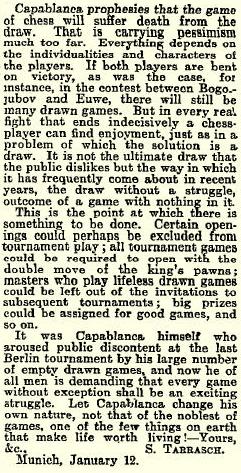
(8480)
Page A3 of the Brooklyn Daily Eagle, 14 February 1928:

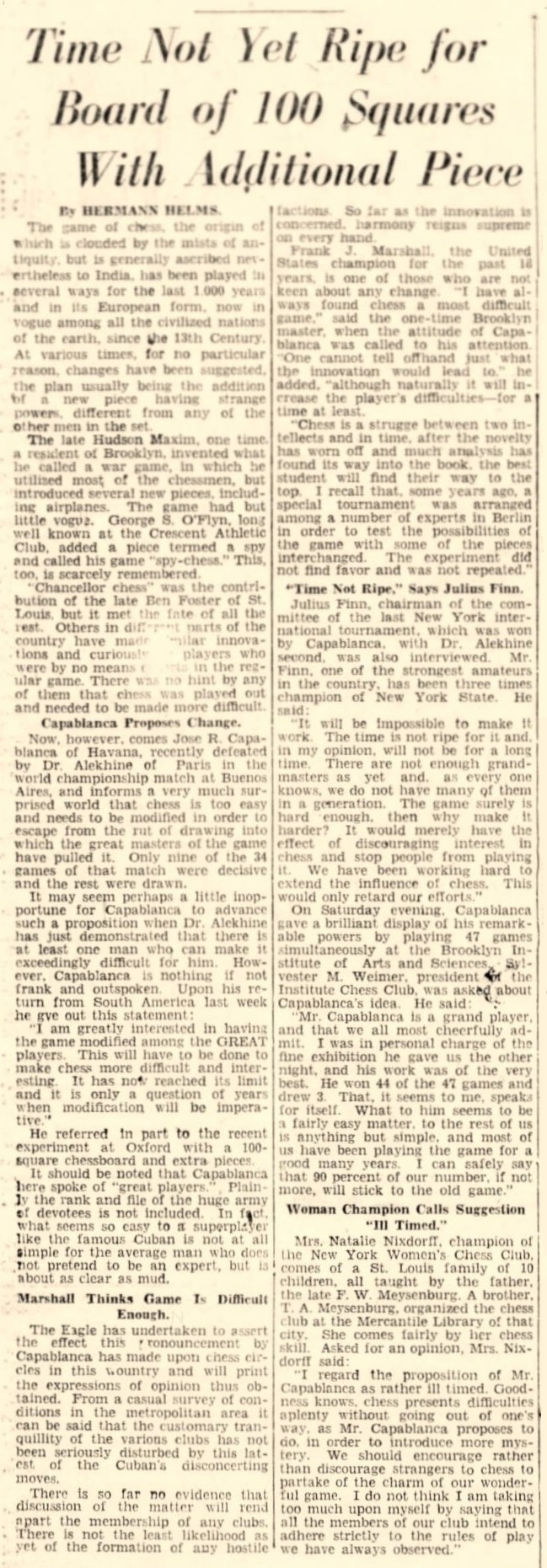
Christian Sánchez (Rosario, Argentina) notes that yet another master who expressed opposition to Capablanca’s proposals was Rubinstein, as reported on page 4A of the Brooklyn Daily Eagle, 16 February 1928.

(8689)
See also the section below on Double chess.
A general discussion of this topic (e.g. the pion coiffé) appeared in C.N.s 1017, 1091, 1122, 1156 and 1327. See pages 123-124 of Chess Explorations.
C.N. 1327 referred to a game on page 80 of the Dictionnaire des échecs by François le Lionnais and Ernst Maget which was headed ‘Max Lange v Schierstedt, Breslau, 1868’. The same information was given on page 431 of Irving Chernev’s 1000 Best Short Games of Chess, and both sources state that White undertook to give mate with his queen’s knight.
In reality, the game was played 12 years earlier, as is shown by pages 238-239 of the June 1858 [sic] issue of the Deutsche Schachzeitung.
Max Lange – Jenny v. S., Halle
October 1856
Pierce Gambit
(To win, White must mate with his queen’s knight.)
1 e4 e5 2 Nc3 Nc6 3 f4 exf4 4 Nf3 g5 5 Bc4 g4 6 O-O gxf3 7 d4 fxg2 8 Bxf7+ Kxf7 9 Qh5+ Kg7 10 Rxf4 Nh6 11 Be3 d6 12 Ne2 Qe7 13 Kxg2 Be6 14 Raf1 Bf7
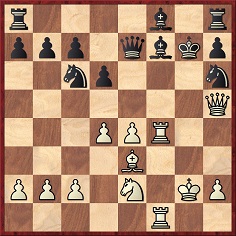
15 Qxh6+ Kxh6 16 Rg4+ Kh5 17 Ng3+ Kxg4 18 Rf5 h6 19 h3+ Kh4 20 Rh5+ Bxh5 21 Nf5 mate.
In C.N. 1327 we expressed some doubt about whether this was a genuine ‘capped knight’ game, given that Black made no attempt to attack the queen’s knight. Richard Forster (Winterthur, Switzerland) now suggests that the identity of the pièce coiffée may have been sealed in an envelope and thus unknown to the odds receiver.
We cannot recall any references in chess literature to this interesting idea.
(2162)
Now we are informed by Richard Forster that the game was presented by Lange on pages 154-155 of his book Sammlung Neuer Schachpartien (Leipzig, 1857) and that Black was identified as ‘Fräulein Jenny von Schierstedt’.
(3502)
From Dominique Thimognier (St Cyr sur Loire, France) comes this game on page 211 of Le Sphinx Journal des Echecs, 1866:
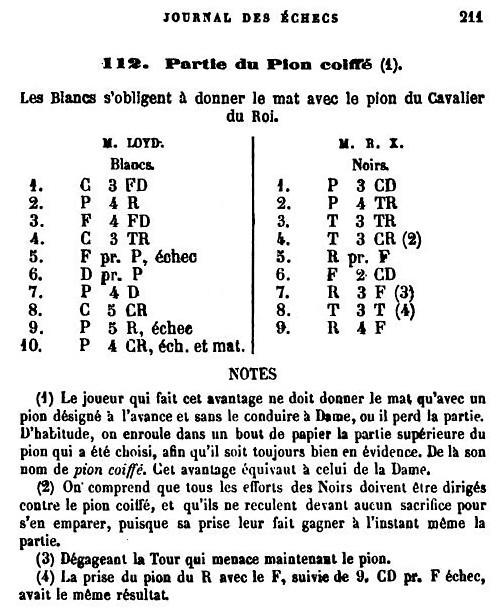
1 Nc3 b6 2 e4 h5 3 Bc4 Rh6 4 Nh3 Rg6 5 Bxf7+ Kxf7 6 Qxh5 Bb7 7 d4 Kf6 8 Ng5 Rh6 9 e5+ Kf5 10 g4 mate. Information on the identity of the players is sought.
Michael McDowell (Westcliff-on-sea, England) notes that page 458 of Sam Loyd and His Chess Problems (Leeds, 1913) had the conclusion of a capped-pawn game between the Loyd brothers. Below is the full score, from pages 207-208 of the Chess Monthly, June 1857:
Thomas Loyd – Samuel Loyd
Occasion?
Queen’s Pawn Game
(White’s g-pawn is capped.)
1 d4 d5 2 Nc3 Nc6 3 Bf4 Nf6 4 a3 Bf5 5 e3 e6 6 Bd3 Ne7 7 Nb5 Bxd3 8 Nxc7+ Kd7 9 cxd3 Ng6 10 Qa4+ Kc8 11 Rc1 Nh4 12 Nxe6+ Qc7 13 Rxc7+ Kb8
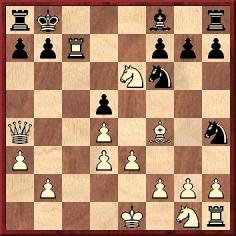
14 Rxf7+ Kc8 15 Rc7+ Kb8 16 Rxg7+ Kc8 17 Rc7+ Kb8 18 Rxh7+ Kc8 19 Rxh4 Rxh4 20 Nxf8 Kd8 21 Be5 Nh7 22 Nxh7 Rxh7 23 Bd6 Rc8 24 Qb5 Rh5 25 Qxb7 Rxh2 26 Rxh2 Rc1+ 27 Kd2 Rxg1 and White gave mate in 11 moves.
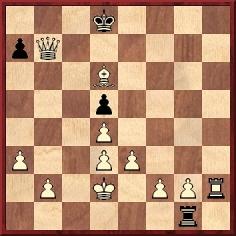
This is the position in the above-mentioned Loyd book, which (whilst noting that ‘there are many duals and short mates in the variations’) gave the following as a mate in 11: 28 Qc7+ Ke8 29 Qc8+ Kf7 30 Rh7+ Kf6 31 Be5+ Kg5 32 Qg8+ Kf5 33 e4+ dxe4 34 Qf7+ Kg4 35 Qe6+ Kg5 36 f4+ exf3 37 Qf6+ Kg4 38 gxf3 mate.
(6093)
From Steinitz’s column in The Field, 7 February 1880, page 151:
‘We give the following game in illustration of the curious complications which arise at the odds of the “kept pawn”. This rare advantage was here given by Mr Mortimer, the inventor of the well-known Fraser-Mortimer variation of the Evans Gambit, and the game was played last month at Holloway Prison, where Mr Mortimer is now confined as a first-class misdemeanant, for having allowed a libel to appear in the Figaro, of which paper he is the proprietor. White gives the odds of the KBP coiffé, and undertakes to mate the adversary with that pawn without queening it.’
1 e3 e5 2 d3 d5 3 Nc3 c6 4 g3 Bd6 5 Nf3 Bg4 6 Bg2 e4 7 dxe4 dxe4 8 Nxe4 Bc7 9 Qxd8+ Bxd8 10 Nd6+ Kf8 11 Nxb7 Bb6 12 Nd6 Ne7 13 a4 Bxf3 14 Bxf3 Nd5 15 a5 Bc5 16 Nc4 Bb4+ 17 c3 Be7 18 O-O Nd7 19 Rd1 N7f6 20 Ne5 Rc8 21 c4 Nb4 22 Bd2 c5 23 Bc3 Nc2 24 Rac1 Nb4 25 Nd7+ Nxd7 26 Rxd7 Na2 27 Rc2 Nxc3 28 Rxc3 Bf6 29 Rb3 g6 30 Rbb7 Ke8 31 Rxf7 Bg5 32 Rxh7 Rxh7 33 Rxh7 Rd8 34 Rh8+ Ke7 35 Rxd8 Kxd8 36 Be4 Bf6 37 Bxg6 Bxb2 38 Be4 Kc7 39 Kf1 Bc3 40 a6 Kb6 41 Bb7 Ka5 42 Ke2 Kb4 43 Bd5 Ka5 44 Kd3 Be1 45 f3 Kxa6 46 g4 Bh4 47 f4 Kb6 48 Kc3 Bf6+ 49 Kb3 a5 50 g5 Bg7 51 h4 Ba1 52 h5 Bg7 53 h6 Bh8 54 g6 Bf6 55 g7 Bh4 56 g8(Q) Bf6 57 h7 Kc7 58 h8(R) Kd7 59 Rh7+ Kd6 60 Be4
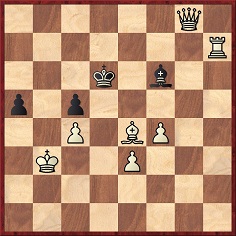
60...Be5 61 Qd8+ Ke6 62 f5 mate.
Black was identified only as ‘Mr B.’ by Steinitz, who annotated the game in depth. His term ‘kept pawn’ may well be an error for ‘capped pawn’.
(9250)
The Dizionario enciclopedico degli scacchi by A. Chicco and G. Porreca (Milan, 1971) mentions a curious meeting between Elias van der Hoeven and Tassilo von Heydebrand und von der Lasa. The initial position was:
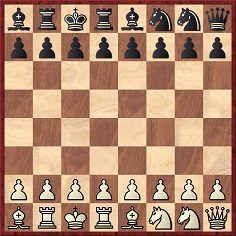
Elias van der Hoeven – Tassilo von Heydebrand und von der
Lasa
Baden-Baden, 1851
1 Nf3 b5 2 d4 d6 3 Ba5 f6 4 Ne3 e5 5 Qe1 Bxf3 6 exf3 exd4 7 Rxd4 Ne7 8 b3 Nc6 9 Nd5 Rb7 10 Re4 Bg6 11 Ne7+ Nxe7 12 Rxe7 Nd7 13 Qe6 Qg8 14 Qxg8 Rxg8 15 Bd4 Ne5 16 Bxe5 fxe5 17 Kb2 Kd8 18 Rxc7 Rxc7 19 Rc1 Kd7 20 Bxc7 Kxc7 and wins.
(31)
George Jelliss (Rugby, England) writes:
‘My own suggestion for injecting new life into the opening phase of chess is what I call “Placement Chess”. The pawns are placed as usual on the second and seventh ranks. Then there is a prelude of four “placements” before the first “displacement” (move) is made. First White places a knight anywhere on the first rank and Black responds by placing his two knights on the eighth rank; the knights must be on different coloured squares, and one of them must be in the same file as the white knight. White then completes this first placement by putting his other knight in line with Black’s other knight. The second and third placements dispose the bishops and rooks according to the same rules. The final placement is of the queens and kings. Here White places his queen and then Black his queen in either of the two available squares; they do not have to be in the same file (though I suspect that most players would choose to place them in the same file rather than have queens facing kings). The kings then fall into the remaining available square, and battle commences. Castling is permitted provided it is not out of, through, or into check and provided the king and rook involved have not moved previously in the game, and is accomplished by moving rook up to king and jumping king over rook, except that when rook and king are next to one another already, “castling” consists of interchanging them. There are 18,432 possible opening positions that can result (= 8x4x6x3x4x2x2x2) from this placement scheme.’
(307)
George Jelliss wonders how, in C.N. 31, the players settled on the odd starting-order BRKRBNNQ, with all the bishops on black squares.
‘It does not seem to be well known that there is just one ordering of the eight pieces on the back row that ensures that all 16 men are guarded in the opening position, namely: NQRBBRKN (or, of course, its reversal). Chess played from this opening position (with black pieces in the same order, queen opposite queen) I call “Guardian Chess”. I offer the following problem: In how many ways can a Fool’s Mate be played in Guardian Chess (i.e. a mate reached in the fewest possible moves)?’
(308)
The answer to the poser set in C.N. 308 is: 403 ways.
1 Ng3 Pc5/6 2 Nf5 Bc7/b6/a5 3 Nxe7 mate (6 ways).
1 Ng3 Pe5/6 2 Nf5 Be7 3 Nxe7 mate (2 ways).
1 Pc3/4 many 2 Bc2 many 3 Bxh7 mate (395 ways).
This compares with eight ways to play the Fool’s Mate (in two moves) from the usual opening position.
(456)
Gordon Pollard (Wallingford, England) tells us that in 1976 he received notice of a Varied Baseline Tournament to be held at the Royal Pavilion, Brighton on 29 February. Each player was free to decide the set-up of his pieces, and after tossing for colour each player had to write down the arrangement of his choice without knowledge of the arrangement chosen by the opponent. Did the tourney take place?
(375)
Michael McDowell (Newtownards, Northern Ireland) and Paul Buswell (St Leonards on Sea, England) inform us that the Brighton Varied Baseline tournament did indeed take place, albeit with only ten entrants. Details are given of the result in the June 1976 BCM and the April 1976 Newsflash. The event was won by D. Springgay with 3½/4, the best-game prize going to the joint second-prize winner, G.H. James. P.H. Clarke published this game in his Sunday Times column of the time, with the following note after White’s seventh move: ‘This attempted assault on the enemy king is doomed to fail because Black already has the stronger grip on the centre – he wisely developed his rooks before the start.’
(426)
Carl-Eric Erlandsson (Lund, Sweden) writes:
‘In 1935 the merchant Friedrich Ladendorf gave invitations to a correspondence chess tournament, for which he offered 300 RM to the prize fund. He made one condition: all games should have the white king on d1 and the white queen on e1 in the starting position (Black Qd8 and Ke8). He wanted all players to have to think for themselves from move one. Fourteen players were on the starting-list, but Miss Sonja Graf and Mr Tischler withdrew. The tournament started on 12 June 1935, but Ladendorf never lived to see the end result; he died on 23 October 1935, aged 62.
The final score was published in Fernschach no. 12/1937. E. Ancsin of Budapest won with +10 =0 –1, ahead of Paul Keres and Hans Müller, both of whom had +9 =1 –1. Keres beat Ancsin, but lost to Müller. I know of only one game published from the tournament: P. Otto (Chemnitz)-J. Klun (Buer-Hassel): 1 e4 c5 2 f4 Qc7 3 Nc3 e6 4 Nf3 Qxf4 5 d4 Qc7 6 Nb5 Qb6 7 Bd2 Qd8 8 dxc5 a6 9 Ba5 Resigns.
Klun scored only +0 =2 –9.’
(935)
A particularly early reference to randomized chess was given on page 330 of the October 1851 Deutsche Schachzeitung:
‘In order to neutralize the advantage which a player might, through study of the classical authors, enjoy over a less learned opponent, Zuylen van Nyevelt recommends in La Supériorité aux Echecs, his work on endgames which was published in 1792, that behind the pawns the two sides’ pieces should be placed in the same sequence as each other, as determined by lot.’
(2467)
On pages xi-xiv of his book Chess Masterpieces (New York, 1928) Frank Marshall discussed various proposals for ‘eliminating the so-called hypermodern style’, the latter term ostensibly meaning for him ‘the tendency on the part of many of the grand masters to adopt an extremely close style of play, which involves a keen desire on the part of both players to avoid incurring the slightest risk’. Of the solutions available, Marshall was inclined to favour balloting:
‘The balloting for openings is of course an old plan in checkers or draughts, but I do not agree with those who think that if adopted in chess matches it would sooner or later lead to a large proportion of draws. In any event it should not be a great hardship for two players to have to play White and Black alternately in selected openings, and I am certain that the public would exhibit a lively interest in a contest where they were sure to see a large number of seldom-played openings which will give a welcome variety after the monotony of the Queen’s Pawn Game.’
(2877)
Eduardo Bauzá Mercére (New York, NY, USA) sends a game from page 8 of the Brooklyn Daily Eagle, 17 January 1894:
John Duryea Elwell – Hermann Helms
Novelty Tournament, Brooklyn, January 1894

1 f3 c6 2 c3 e5 3 d4 Ne6 4 e3 d5 5 Nb3 f6 6 Bf2 Bf7 7 Bd3 Ne7 8 Ng3 O-O 9 O-O Bg6 10 Qc2 f5 11 dxe5 Bxe5 12 f4 Bc7 13 Nd4 Nxd4 14 cxd4 Qd7 15 b4 Rae8 16 Rfe1 Nc8 17 Rac1 Re6 18 Nxf5 Ref6 19 Nh4 Bxd3 20 Qxd3 Nd6 21 Nf3 Ne4 22 Ne5
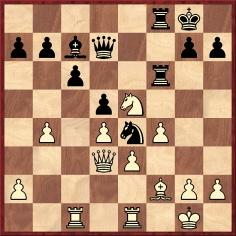
22...Qf5 23 Qe2 Nxf2 24 Qxf2 Bxe5 25 dxe5 Qxe5 26 Qd2 Qe4 27 g3 Re6 28 Qd4 Rfe8 29 Kf2 Qf5 30 Qxa7 R8e7 31 a4 g5 32 Qc5 Qh3 33 Kg1 gxf4 34 Rc2 Rxe3 35 Rf1 Re2 36 Rxe2 Rxe2 37 White resigns.
Other examples of displacement chess are on pages 88-90 of The Encyclopedia of Chess Variants by D.B. Pritchard (Godalming, 1994).
(6438)
Mr Bauzá Mercére (New York, NY, USA) also submits a game from pages 248-250 of Sissa, 1853:
Baron van der Hoeven – Spoelstra
Nijmegen, 1852
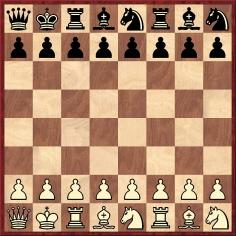
1 e3 d5 2 Bf3 f6 3 Nd3 e5 4 e4 b6 5 Bg4 dxe4 6 Bxc8 exd3 7 Bh3 dxc2+ 8 Rxc2 Qe4 9 f3 Qd3 10 Re1 Nd6 11 Re3 Qg6 12 Ng3 Nc4 13 Re2
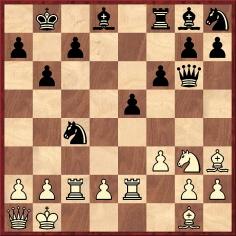
13...h5 14 Bf5 Qg5 15 Bd3 Na5 16 b4 Nb7 17 Qc3 Nf7 18 Be3 Qh4 19 Nf1 Nfd6 20 Bf2 Qg5 21 Ng3 Qh4 22 Ne4 Qxh2 23 Nxd6 Nxd6 24 Qc6 f5 25 g3 e4 26 Bc5 Qxg3 27 Bxd6 Qxd6 28 Qxd6 cxd6 29 fxe4 f4 30 e5 f3 31 Rf2 dxe5 32 Be4 Bh4 33 Rxf3 Rxf3 34 Bxf3 Bh7 35 Bxh5 Bxc2+ 36 Kxc2 Kc7 37 Bg6 Kd6 38 Kc3 Ke6 39 d4 Be1+ 40 Kc4 exd4 41 a3 Bf2 42 Kb5 Kf6 43 Bd3 g5 44 a4 g4 45 Kc4 Ke5 46 Be2 g3 47 Bf3 Kf4 48 White resigns.
(7370)
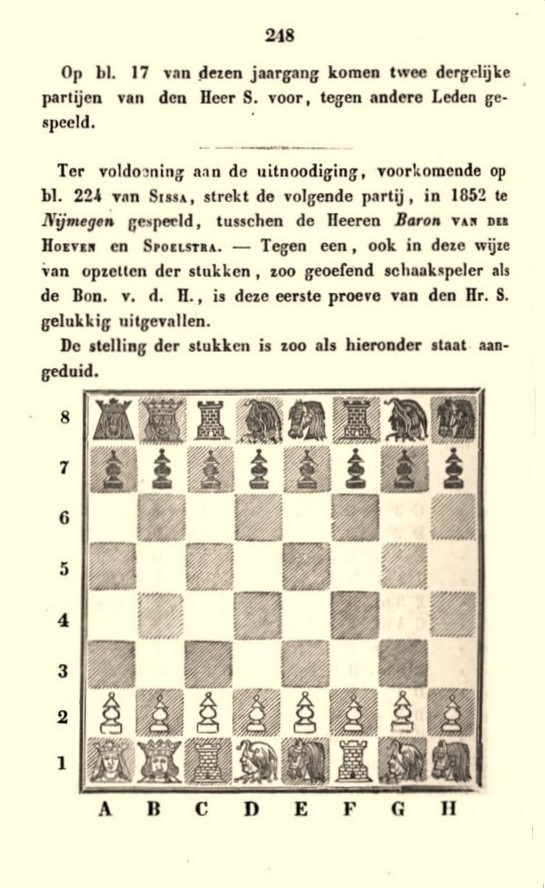
Sissa, 1853
Thomas Niessen (Aachen, Germany) notes a comment about randomized chess on page 365 of Paul Rudolf von Bilguer’s Handbuch des Schachspiels (Berlin, 1843), to the effect that the advantage of openings knowledge could be neutralized by Nieveld’s method of drawing lots to determine the array, although it tended to lead to uninteresting games:
‘Den Vortheil, welchen Jemand aus dem Studium der Eröffnungen erlangt hat, kann man auch auf die vom General Nieveld in seiner Supériorité aux Echecs empfohlene Weise paralysiren. Die Officiere werden nämlich hinter den Bauern gleichförmig auf die erste und achte Reihe, aber in einer durch das Loos bestimmten Ordnung postirt. Es scheint, als sei diese Methode bei den Holländern häufig in Gebrauch, obgleich sie, wie die indische, offenbar den Nachteil hat, gewöhnlich uninteressante Spiele herbeizuführen.’
The Handbuch then gave this specimen game from page 62 of the 15 August 1842 issue of Le Palamède:
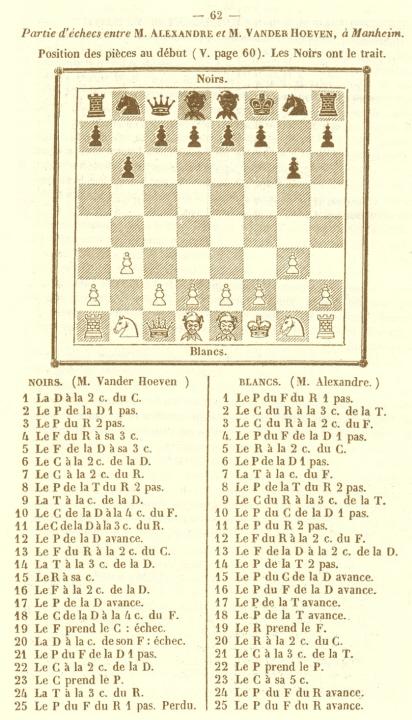
van der Hoeven – Aaron Alexandre
Mannheim, 1842
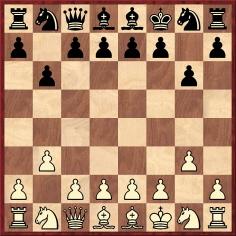
1 Qb2 f6 2 d3 Nh6 3 e4 Nf7 4 Bf3 c6 5 Bc3 Kg7 6 Nd2 d6 7 Ne2 Rf8 8 h4 h5 9 Rd1 Nh6 10 Nc4 b5 11 Ne3 e5 12 d4 Bc7 13 Bg2 Bd7 14 Rd3 a5 15 Ke1 b4 16 Bd2 c5 17 d5 a4 18 Nc4 a3 19 Bxh6+ Kxh6 20 Qc1+ Kg7 21 c3 Na6 22 Nd2 bxc3 23 Nxc3 Nb4 24 Re3 f5 25 f3
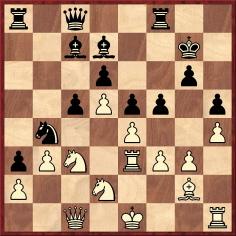
25...f4 and wins.
(7398)
Jan Kalendovský (Brno, Czech Republic) has sent this photograph:
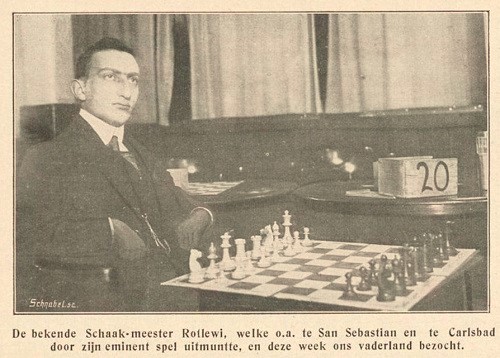
De Revue der Sporten, 8 November 1911, page 410
(9514)
C.N. 3480 presented a wordless book review, but the most celebrated brief critique is Tony Miles’ two-word dismissal of an Eric Schiller volume, on page 56 of the Autumn 1998 Kingpin. Now we note the following in the review section on page 78 of the July-September 2005 issue of Stefan Bücker’s magazine Kaissiber (each issue of which represents an extraordinary amount of work):
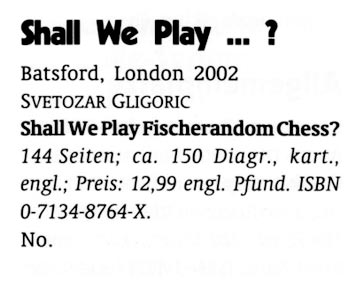
(3794)
Fischer v Gligorić Training Match (1992) includes the following text which Svetozar Gligorić wrote to us in March 2012:
‘My friendship with Bobby started when he was 15 years old, and I was 35. It lasted about 40 years. During the two decades of his self-isolation I was one of the very few people who were in regular contact with him.
In 1992 Bobby arrived in Belgrade, several weeks before the beginning of his second match with Spassky. In advance of the match he asked for my help in delivering to him all games played during the 20 years of his absence from chess. I had a little-known computer, and Bobby was unpleasantly surprised by the enormous increase in the number of games with each opening variation which he had in his repertoire. That is when he began to think of reforming the rules of chess at all costs, removing the very tiring task of preparing openings in advance for each game. He spent a year or two trying to persuade me to write a book about Fischerandom chess. I eventually did so. My book, Shall We Play Fischerandom Chess?, was published in London in 2002, while he was still alive.’
The ‘Changing the Rules’ chapter of our Capablanca book also discussed Double Chess, and we had the pleasure of transcribing this game from pages 323-324 of the November 1929 issue of Magyar Sakkvilág:
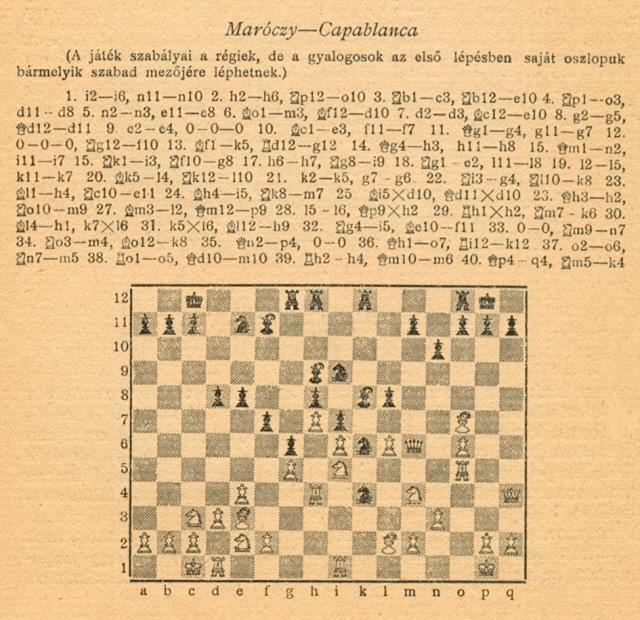
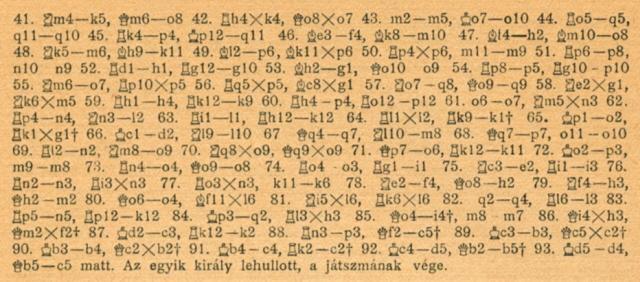
The photograph below of Capablanca and Maróczy in play was published on page 53 of Alt om Skak by B. Nielsen (Odense, 1943):
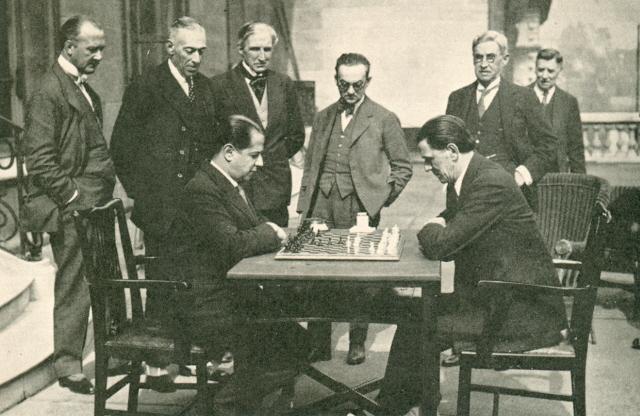
(5619)
A contribution from Olimpiu G. Urcan:
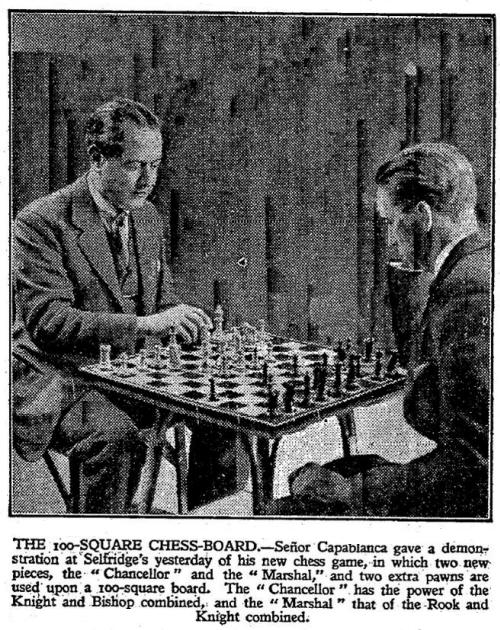
The Times, 12 April 1929, page 18.
(8178)
C.N. 5619 showed a game of Double Chess between Maróczy and Capablanca on pages 323-324 of the November 1929 issue of Magyar Sakkvilág. The game-score was also on page 197 of L’Echiquier, May 1929:
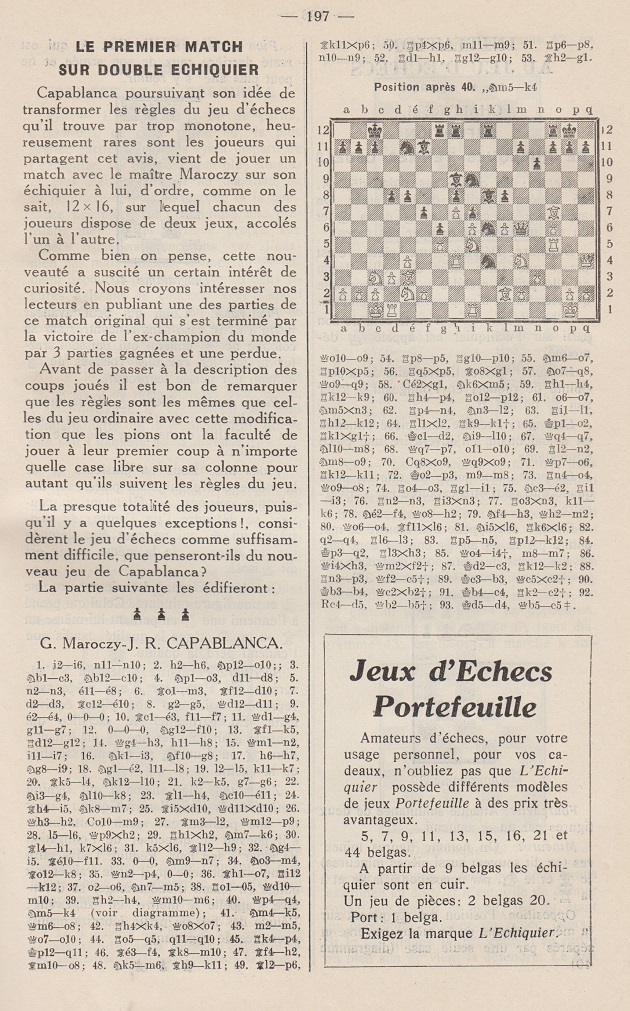
(10446)
From Gerard Killoran (Ilkley, England) comes this item on page 7 of the Leeds Mercury, 28 November 1928:
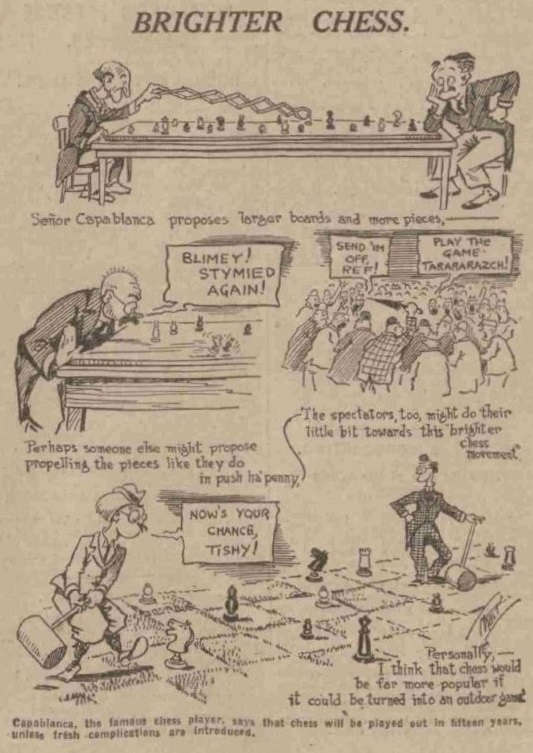
(10167)
From our archives:
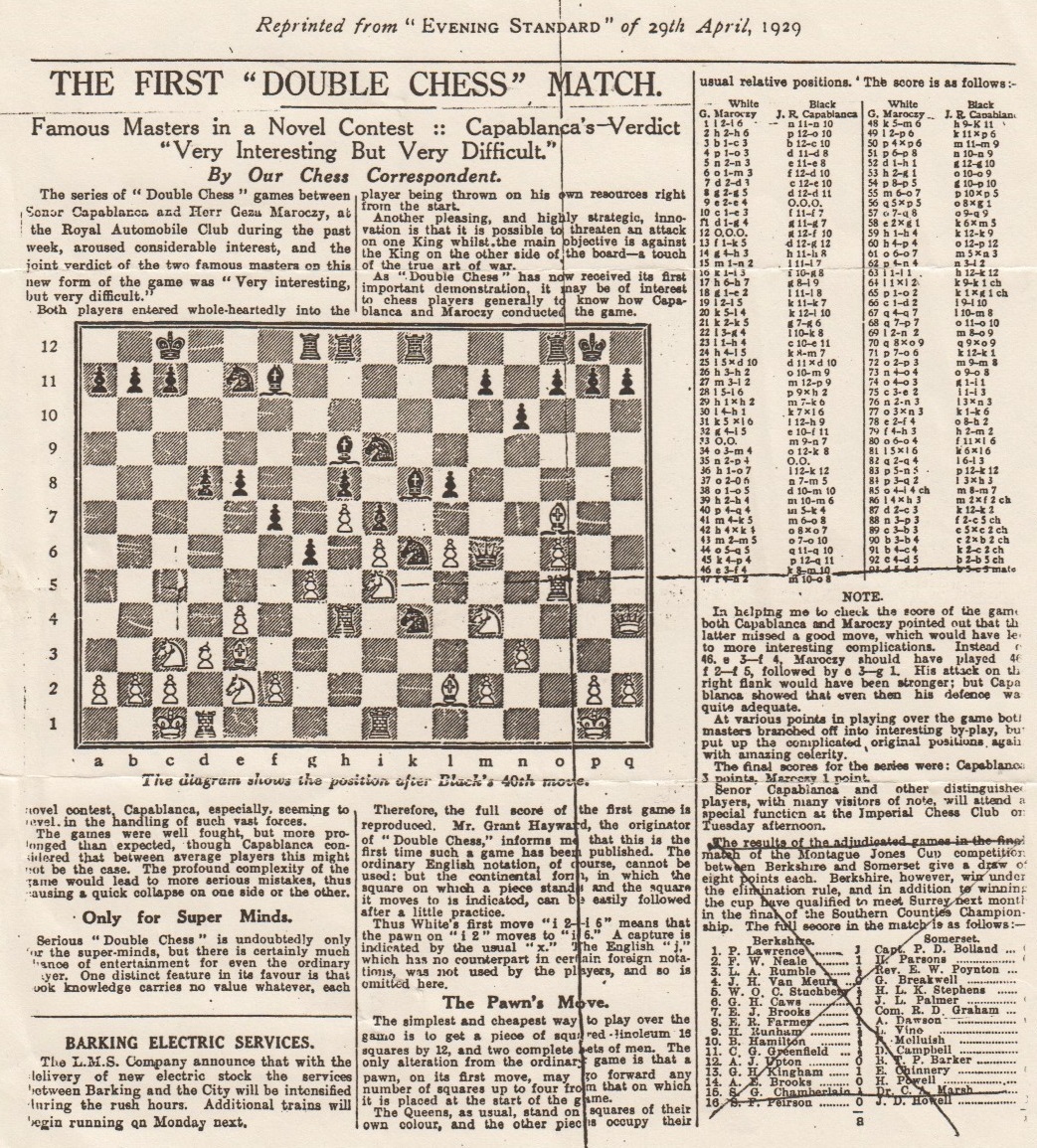
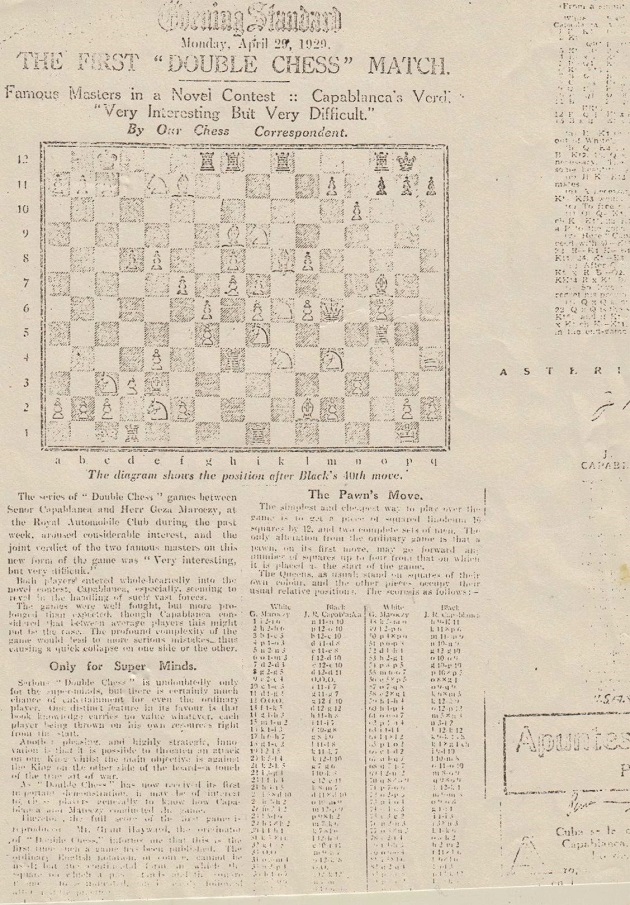
The article’s exact original appearance in the Evening Standard newspaper is not currently to hand.
On the subject of Capablanca’s proposals for different forms of chess, Richard Forster (Winterthur, Switzerland) has found the following on page 3 of the Moscow Daily News, 23 April 1935 (‘Translated from Komsomolskaya Pravda’):

(11861)
Owen J. Clarkin (Ottawa, Canada) quotes from The Modern Chess Instructor by W. Steinitz (New York, 1889):
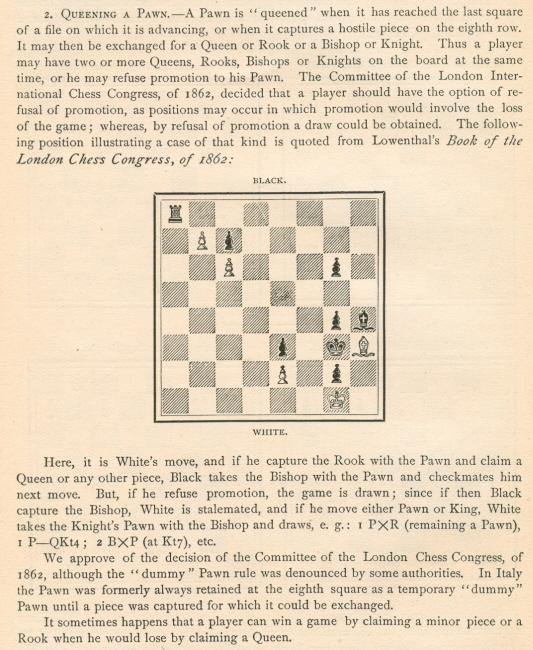
Mr Clarkin asks the following:
‘(1) Was “non-promotion” generally allowed in the mid- to late-1800s, i.e. to what extent were the Code of Laws of the British Chess Association of 1862 adopted? On page xx of his book Steinitz claimed that they were applied “... in many Chess Congresses”.
(2) What more is known about the bishop and pawn ending presented by Steinitz on page xxiv, which was given in the entry on promotion in The Oxford Companion to Chess as a composition by Kling?
(3) Are there any known instances of a pawn retaining its identity on the eighth rank in over-the-board play?
(4) Is it known whether Steinitz always supported rules allowing non-promotion?
(5) Under what circumstances was it generally decided that a pawn reaching the eighth rank must be promoted?’
We hope to revert to these matters in due course, and readers’ contributions will, as ever, be appreciated. Firstly here, it may be noted that the position given by Steinitz had appeared, attributed to Kling, on page lxxii of Löwenthal’s book on London, 1862, introduced as follows:
‘Mr Staunton maintained that to allow a pawn at its eighth square to remain a pawn was a serious innovation, a gross absurdity and a violation of the fundamental laws of the game. In reply, it was pointed out that a pawn remaining a pawn at its eighth was no novelty, Mr Staunton himself giving in the Praxis a game from Ponziani in which an example occurs; that the law relative to the point had been altered several times; that as to the reproach of innovation, the game itself was nothing but the result of a series of innovations on its original form; and that Mr Staunton had admitted in the Praxis that the tendency of modern legislation was to consider the queening a pawn as the highest feat which a player can accomplish, and to reward it with the greatest possible advantage. It was urged that to compel a player to choose a superior piece without the option of refusing promotion would not in all cases confer the greatest possible advantage, there being positions in which a player compelled to take a superior piece would be subjected to a fatal penalty, the following being an instance adduced by Mr Kling ...’
In the Kling position The Companion had a white pawn, not bishop, on h3.
As regards the game given by Ponziani, the following score appeared on pages 41-42 of Staunton’s Chess Praxis (London, 1860):
1 e4 e5 2 f4 exf4 3 Nf3 Be7 4 Bc4 Bh4+ 5 g3 fxg3 6 O-O (Kh1, Rf1) d5 7 Bxd5 Bh3 8 Bxb7 g2+ 9 Kg1 gxf1
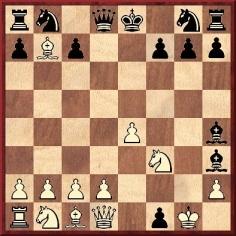
10 Bxa8 Bf2 mate.
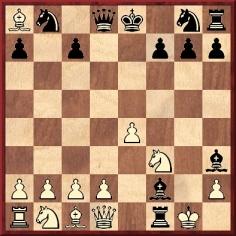
The unit on f1 had to remain a pawn until it could be replaced by a captured black piece.
Staunton wrote:
‘There is so much of the absurd about such a finale as this that no-one will consider it worthy of serious examination, and it is only mentioned as a matter of curiosity.’
Pages 219-221 of the Chess World, 1865 had a letter from W.S. Pavitt of Chelmsford on the dummy pawn (‘that exquisite stroke of chess legislation’) in the context of chess problems, and the following item was published on page 311 of the American Chess Journal, April 1879:
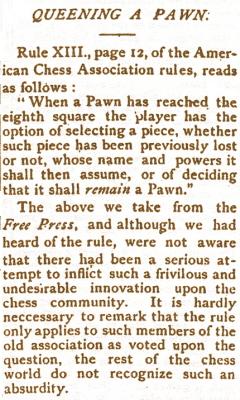
(5791)
From page 76 of the 20 September 1851 issue of the Chess Player (edited by Kling and Horwitz):
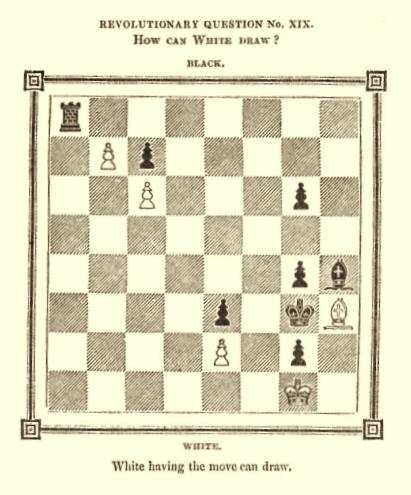
The ‘Answers to Correspondents’ section in the same issue (page 80) had the following:
‘We are of opinion that a pawn, when reaching his eighth’s square, is entitled to become any piece the player thinks best; and, naturally enough, if it prove disadvantageous to become a piece, it may still remain a pawn. (See Diagram 19.) This question among others, we thought, should have been discussed at the Tournament.’
Another ‘answer’, on page 96 of the 4 October 1851 Chess Player:
‘We are glad to hear that you think a pawn should also have the privilege of remaining a pawn when reaching the eighth square; but we hardly think it practicable as the law now exists.’
The above composition was referred to on page 175 of the Westminster Papers, 1 December 1873:
‘After mature consideration, we can see no utility in a controversy about the dummy pawn. So far as we know, it was first suggested in this country in 1851, in a two-penny publication called the Chess Player, and was illustrated by an absurd problem, aptly enough baptized by the composer “Revolutionary”. The problem, which in 1851 passed current for a tolerable joke, was in 1862 “adduced” as a serious argument, and appears to have convinced some worthy people that it embodied an excellent principle. To J.M.R., who enquires, “Could not a game be invented to show the usefulness of the regulation?” we answer, yes; and more, the players might be invented also. The wonder is, that the double event has not been “managed” long ago.’
The chess column on page 36 of the 5 September 1874 Illustrated London News referred to the ‘famous “dummy pawn” epidemic’. A more recent curiosity is the entry on page 54 of the Dictionary of Modern Chess by Byrne J. Horton (New York, 1959), which did not make it clear that the dummy pawn rule had long ago become obsolete everywhere:
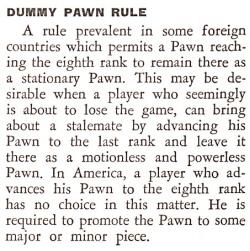
(7619)
Ross Jackson (Raumati South, New Zealand) points out news items in the chess column of the Otago Witness, 20 July 1899, page 48, and 4 October 1905, page 70:
‘It is surprising to note that provisions such as the touch-move rule and the possibility for a pawn reaching the eighth rank to remain a pawn were officially still in force in New Zealand until the end of September 1905.’
(11761)
Alessandro Nizzola (Mantova, Italy) writes:
‘I recently discovered an unknown game by Adolf Anderssen, a loss against Dubois. It was played according to the Italian rules of castling, at the home of Löwenthal. The source is a sheet manuscript which was owned by the nineteenth-century Italian player Francesco Discart and is now in my possession.’
Adolf Anderssen – Serafino Dubois
London, 1862
Muzio Gambit
1 e4 e5 2 f4 exf4 3 Nf3 g5 4 Bc4 g4 5 O-O (Kh1, Rf1) gxf3 6 Qxf3 Bh6 7 d4 Qh4 8 Nc3 Ne7 9 Bd2 d6 10 Rae1 Nbc6 11 Nb5 Bg4 12 Qb3 O-O-O (Kb8, Rc8) 13 Bc3 f5 14 e5 dxe5 15 d5 Nd4 16 Nxd4 exd4 17 Bxd4 Rhe8 18 Re6 f3 19 g3 Qh3 20 Rf2 f4 21 Ba6 b6 22 Rxb6+1 cxb6 23 Bxb6 Nxd5
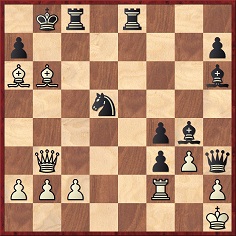
24 Bxa7+ Kc7 25 Qc4+ Kd6 and wins.
(2337)
On page 82 of A Chess Omnibus we added this note regarding 22 Rxb6+:
It seems that after 22 Bxb6 White would not stand worse.
Mr Nizzola adds:
‘I now learn that the game was published in the Nuova Rivista degli Scacchi, 1 December 1875, page 87, and that it was played on 29 June 1862. My new source is the book Serafino Dubois, il Professionista by A. Innocenti and L. Barsi (Messaggerie Scacchistiche, Brescia, 2000), as well as a letter in the June 2000 L’Italia Scacchistica (page 258) from a reader, Giovanni Lucci.’
(2414)
Fabrizio Zavatarelli (Milan, Italy) writes:
‘I recently acquired several chess-related postcards addressed to Ferdinando Cassoli Lorenzotti, the strongest player in Modena after the departure of Discart and Bonetti from the city. Some of the cards contain moves in two still-unknown correspondence games between Modena and Genova played in the winter of 1880-81.
One of the games was played under the old Italian rules: no en passant captures; free castling (the king being allowed to go anywhere along his rank, and the rook anywhere between the king and e1/e8, but without being able to give check); restricted promotion (pawns able to promote to captured pieces only, but could also be left unpromoted). Unfortunately, the scores are incomplete and their use of the descriptive notation does not help. I have the following moves (the notes being by Giacomo Cuniali, the leader of the Genovese team, in my translation from the Italian):
Modena-Genova (played under the old Italian rules)
1 ... 2 ... 3 ... 4 ... 5 ... 6 P-Q3 P-KR3 7 P-KR3 B-QN3 8 ... 9 ... 10 ... 11 ... 12 N-KN1 N-KB5 13 ... 14 P-Q4 P-KN4 15 PxP PxP At the moment, it seems to us, a statement about the final outcome of our games should be premature. 16 R-Q1 Q-K2 17 Q-K3 P-KN5 18 P-KR4 P-KN6 Our games are beginning to be interesting and therefore entertaining. [...] I proposed and endorsed the move 18...NxKP until the last minute, but none of my fellow players approved of it, since they considered it less good than 18...P-N6; I eventually accepted the latter, to respect the majority; moreover, 18...P-N6 promises to be a fine continuation as well. [...] If 18...NxP 19 P-KN3 B-B4 at this stage we tried many lines, but the outcome was always unclear because of their countless variations; rather, after many combinations White stood better. Having time, we could study the position more; but we are all busy from morning until night. 19 PxP N-KN5 In one game the attack is ours, in the other it is yours, but so far the situation is hopeless for neither of us. 20 Q-K1 N-R4 21 N-KB3 R-KN1 & K-KR1 [Italian castling] 22 QN-Q2 N(N5)-KB3 23 QN-KB1 R-KN5. Had Black played 23...R-N3 or 23...B-Q2 or 23...B-N5 [then] 24 R-Q3, followed by R-K3 and N(f3)-R2. Here I see White well entrenched, while Black is helpless, all the more so as Black, owing to his positions, would be lost with the slightest shock. [...] If we played 23...B-Q2 24 R-Q3 R-N3 25 R-K3 QR-KN1 26 N[3]-Q2, I said 26 N[3]-R2, thinking of 23...B-KN5. 24 Q-Q2 K-N2 The game, in my opinion, is decidedly drawn because of the move 24 Q-Q2; but we could avoid it only by jeopardizing the game. 25 Q-Q8 QxQ 26 RxQ NxKP 27 BxP KxB If 27 NxKP+ K-K2.
Genova-Modena (played under the standard international rules)
1 ... 2 ... 3 ... 4 ... 5...N-KB3 6 B-Q3 B-K2 7 Castles ... 8 ... 9 ... 10 ... 11...NxB 12 QxN ... 13...P-QR3 14 N-QN3 N-KN5 15 NxB At the moment, it seems to us, a statement about the final outcome of our games should be premature. 15...QxN 16 P-KN3 Q-K4 17 B-B4 Q-R4 18 P-KR4 Our games are beginning to be interesting and therefore entertaining. 18...B-B4 19 Q-Q2 In one game the attack is ours, in the other it is yours, but so far the situation is hopeless for neither of us. In this game we made a very bad move, which was enough for us to be attacked; it was Nd4-b3. 19...N-B3 20 P-KB3 Q-N3 21 R-KB2 KR-K1 22 N-Q4 P-KR4 23 P-QB3 N-Q2 24 K-R2 There is nothing for either party to do, in my opinion, as always happens in the games in which the French and the Sicilian Defences are adopted. 24...N-B4 25 R-KN1 N-K3 26 NxB If 26...QxN 27 B-K3.
It would be interesting to reconstruct the full scores of both games. Knowing their openings would be helpful, but they are stated ambiguously. The Modena-Genova contest is called the “Italian Game”, but that may mean either “the opening is an Italian Game” or “the game is played under the Italian rules”; similarly, the Genova-Modena game is often called “French Game”, which may mean either “the opening is a French Game” or “the game is played under the French rules”. In Italy the international rules were called “French” because they were first codified in a book printed in Paris in 1668 and were subsequently sanctioned by Philidor’s treatise. To complicate matters further, on the postcards the Genova-Modena game is once called “English” and once alluded to as “Sicilian”.
I propose a reconstruction of the “Italian” Modena-Genova game:
1 e4 e5 2 Nf3 Nc6 3 Bc4 Bc5 4 c3 Nf6 5 Castles (Kh1, Rf1) d6 6 d3 h6 7 h3 Bb6 8 Qe2 Ne7 9 Be3 Ng6 10 Bxb6 axb6 11 Bb3 c6 12 Ng1 Nf4 13 Qf3 b5 14 d4 g5 15 dxe5 dxe5 16 Rd1 Qe7 17 Qe3 g4 18 h4 g3 19 fxg3 Ng4 20 Qe1 Nh5 21 Nf3 Castles (Kh8, Rg8) 22 Nbd2 Ngf6 23 Nf1 Rg4 24 Qd2 Kg7 25 Qd8 Qxd8 26 Rxd8 Nxe4 27 Bxf7 Kxf7 (28 Nxe5+ Ke7).
Can any improvements be made to my reconstruction, and is it possible to reconstruct the second game? I should also like to know whether any other postcards relating to the two games have survived.’
(10687)
The inventor of Kriegspiel was Michael Henry Temple (1862-1928),
whose photograph appeared in C.N. 3487:
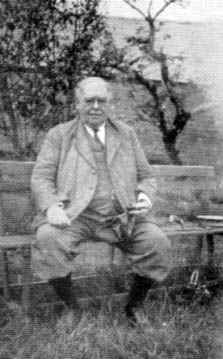
One of the few top-level chess masters to have taken up Kriegspiel was Alekhine, as is shown by two quotes from the 1926 BCM (March, page 124 and July, page 314 respectively):
‘Monsieur Alekhine (now a naturalized Frenchman and an official representative of French chess) remained in this country for a short time after his success at Hastings. On 9 January he spent the afternoon at the Imperial Chess Club playing Kriegspiel and beat every one of his opponents.’
‘The Kriegspiel Tournament [in Scarborough] was won by Alekhine, who is an adept at this lighter branch of the game, and Mrs Stevenson gained a popular success in coming second.’
(3496)
Michael McDowell (Westcliff-on-sea, England) quotes the following from page 16 of A Tribute to G.F. Anderson compiled by G.W. Chandler, C.R. Flood and R.C.O. Matthews (published by the British Chess Problem Society in 1974):
‘The logical element in Kriegspiel problems gives them an appeal to players that many conventional problems lack. Not long after Are There Any? was published, Robert C. Stephenson, one of our members, wrote to Anderson:
“I write because I must have another copy of Are There Any? I had solved only up into the thirties when last night I incautiously carried it down to the Marshall Club to show it to Jack Collins. Then, seeing it in Jack’s hands, Bobby Fischer pounced upon it in great excitement and before the evening was over the two of them had so made it theirs, were so comically oblivious of the mere owner, that I hadn’t the heart to explain that I had brought it to show, not to bestow.”’
Our correspondent comments:
‘Anderson’s 1959 book Are There Any? is a fascinating collection of Kriegspiel problems. I am not aware of any other reference to Fischer showing a direct interest in the composition side of chess (as opposed to Benko setting him problems to solve).’
(3994)
Paolo Ciancarini (Pisa, Italy) asks for information about the inventor of Kriegspiel, Michael Henry Temple, of whom a photograph was given in C.N. 3487 (from the December 1928 BCM).
That issue of the magazine (pages 448-449) carried Temple’s obituary, and we shall be grateful for any biographical details that readers can add.
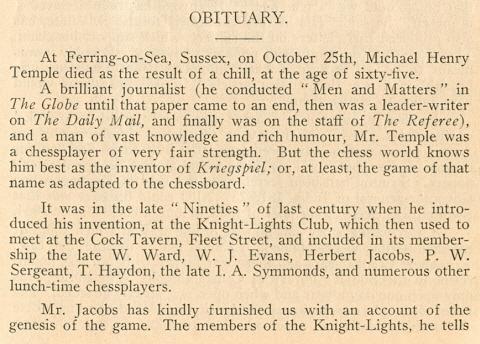
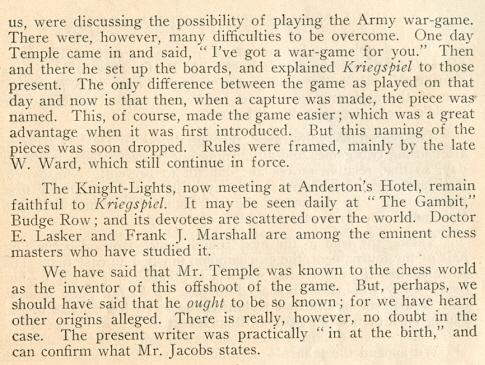
(6415)
Olimpiu G. Urcan (Singapore) has a report about the Gambit Chess Rooms, London on pages 23-25 of Picture Post, 12 January 1946. Below is the final page:
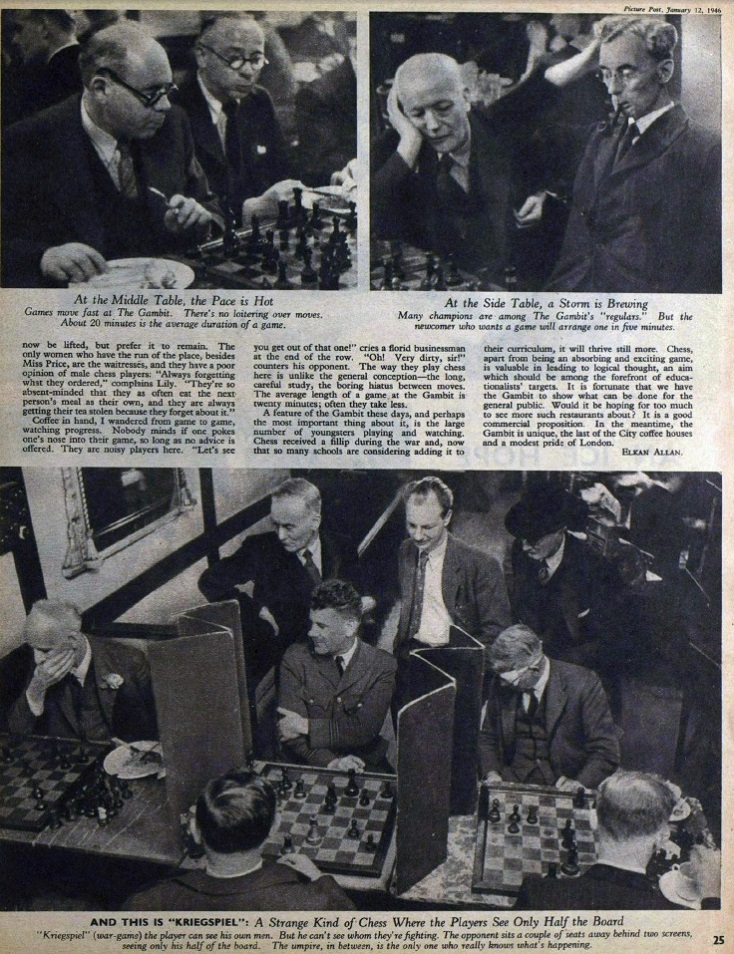
(8975)
The entry on Michael Henry Temple in the unpublished 1994 edition of Chess Personalia by Jeremy Gaige:
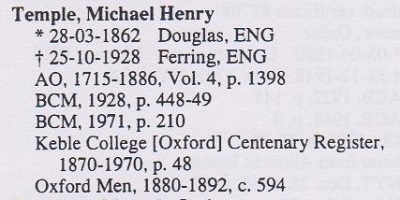
Oxford Men can be viewed on-line, and below is Temple’s entry:

From page 10 of the Yorkshire Post and Leeds Intelligencer, 27 October 1928:
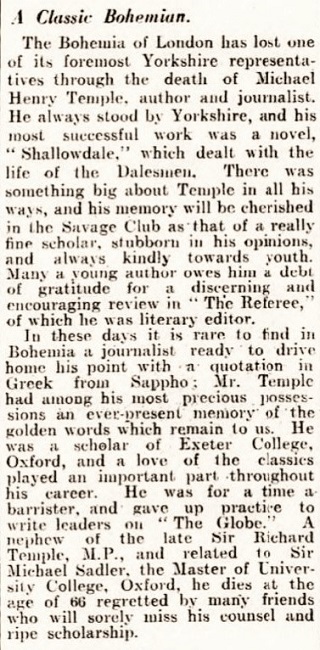
David Garnett, the sexton of St Andrew’s Church, Ferring, informs us that the Isle of Man Parish Registers record that he was the son of Charles and Hannah Maria Temple and was baptized in Onchan, Isle of Man on 20 April 1862. His death was briefly reported on page 17 of The Times, Saturday, 27 October 1928:
‘Mr Michael Henry Temple, author, journalist and naturalist, died on Thursday, at Ferring, Sussex, at the age of 66. The eldest son of Mr Charles Temple, of Douglas, Isle of Man, he went up to Keble College, Oxford, and took his degree in 1884. In 1886 he was called to the Bar by the Inner Temple. He was at one time on the staff of the Globe, and was known for his studies of Nature and rural life.’
Mr Garnett, who has taken three photographs of the cemetery in St Andrew’s Church, adds that the gravestone inscription reads:
‘In bright memory of Michael Henry Temple, barrister at law 1921-1923, resident in Ferring 1927-1928, born March 28th 1862, died October 25th, 1928.’
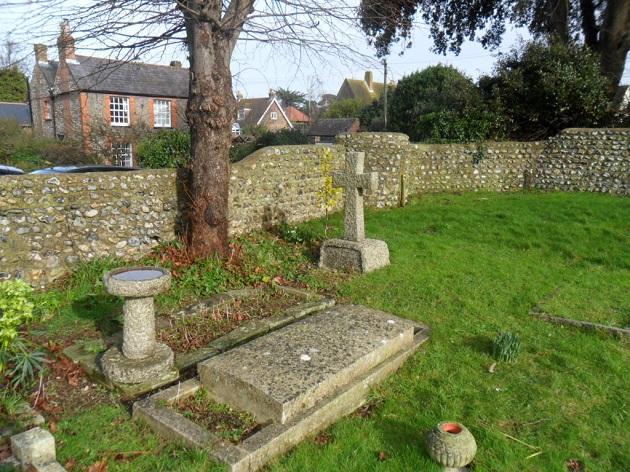

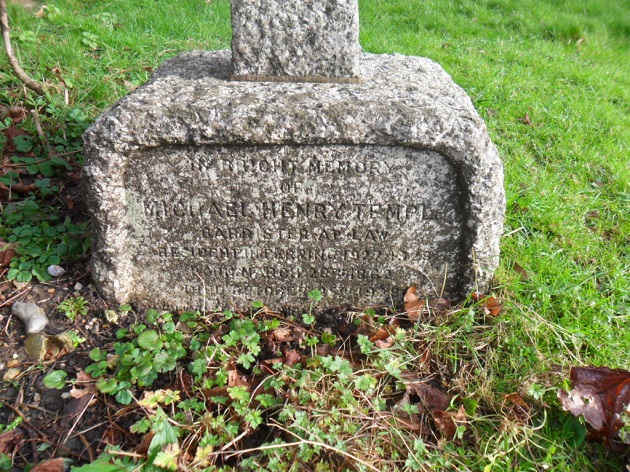
(9727)
From page 4 of the 23 February 1935 Daily Express:

The ‘William Hickey’ column sometimes had a chess diagram, but it is the subsequent item, about ‘Dr Kratky’, that catches the eye, although there was nothing topical about his proposed ‘deviation’, Laureat, from regular chess. The report below had appeared on page 10 of The Observer, 7 September 1930:

There ensued numerous similar items in newspapers around the world (similar, not least, in misspelling the name Spielmann). Additional information about Bedřich Krátký available online includes a photograph sold in a Czech auction in July 2020.
(12180)

Following on from C.N. 1426, below is another specimen, culled from page 87 of La Stratégie, April 1925:
Campbell and I. Rossow – Robert Crépeaux
Occasion?
1 Nf3/Nc3 b5/Bb7 2 b4/e4 g5/Bg7 3 Bc4/Nxg5 Bd5/Bxc4 4 d3/Bf4 h6/hxg5 5 Bxc7/Bxd8 Bxd3/Bc4 6 Qc1/Kd2 Be5/Bf4+ 7 White resigns.
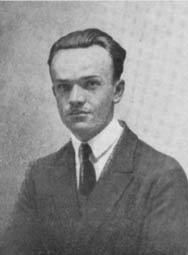
For further information on Marseillais chess, see pages 187-190 of D.B. Pritchard’s excellent volume The Encyclopedia of Chess Variants (Godalming, 1994).
(3479)
See too C.N. 10803 in Arthur Koestler and Chess.
See Stalemate, which includes the following:
In a letter on page 7 of the January 1937 Chess Review Herbert Harvey proposed a rule change whereby a pawn would ‘become by promotion automatically the piece appropriate to the file on which it is promoted’. A choice of pieces would exist only in case of promotion on the king’s file.
On page 29 of the following month’s issue Paul H. Litwinsky (later: Paul H. Little) related an ‘offhand remark’ by Capablanca at Nottingham, 1936, regarding stalemate:
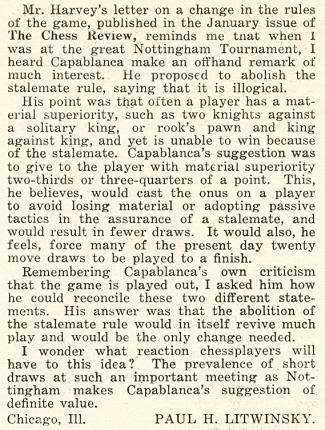
(7051)
See too in our above-mentioned Stalemate article the references to T.H. Tylor’s proposal to change the stalemate rule.
A peculiar game is to be found on pages 132-133 of the April-May 1912 Wiener Schachzeitung. White played without his queen, Black without his queen’s rook. As compensation White could make six moves before Black replied (presumably being restricted to the first four ranks).
K. Andreaschek – Dr Robert M.
Olmütz, 13 March 1901

1-5 e4, d4, Nc3, f4, Nf3, 6 Bc4 d6 7 h3 Nd7 8 Bxf7+ Kxf7 9 Ng5+ Kf6 10 Nd5+ Kg6 11 f5+ Kh6 12 Nf7+ Kh5 13 g4+ Kh4 14 Kf2 e5

15 Ne3 and mate next move by 16 Ng2.
Any other good examples of players offering their opponents the right to open in such a way?
(356)
C.N. 356 reminds Philipp Mottet (Zuchwil, Switzerland) of an incident reported by Theo Schuster on pages 35-36 of Schachkuriosa (Stuttgart, 1977). In Berlin in 1898 Winawer agreed to play a game with an unknown amateur, with ‘X’ receiving the right to play for five minutes with the white pieces, none being authorized to go further than the fourth rank. White played 1 a4 2 Na3 3 h4 4 Nf3 5 d4 6 Nd2 7 Rh3 8 Nac4 9 Raa3 10 Ne4 11 Qd2 12 Rhf3 13 g3 14 Bh3 15 Qf4 16 Rae3 and the rest of the time played with his king.
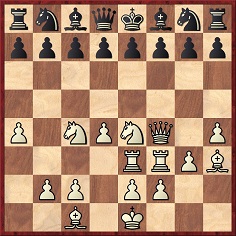
Winawer left without making a move – he is mated in two.
One never knows whether such stories are to be believed.
(463)
From Frank Skoff (Chicago, IL, USA):
‘As to C.N. 463, the same position is given in Fine’s Chess The Easy Way (Philadelphia, 1942), page 30, although his order of moves differs from that given by Schuster. Fine comments before giving his answer:
“Even if you were limited to the first four ranks, you could force an overwhelming position quickly. Make 16 moves, and you can maneuver in such a way that mate in two is unavoidable. (Odds of ‘Make as many moves as you like’ are occasionally given, even to strong players, so that the best continuation is worth reproduction here.)”
He then gives the 16 moves.
The position may be something some problemist, like Sam Loyd, would like to propound to the public, though I have no hard facts in that respect. It also suggests that many of the anecdotes attributed to various masters throughout chess history must be skeptically viewed until their sources are checked, if any. In the field of history, I am sure that many of the quotes – at least some – attributed to Winston Churchill are dubious, to say the least; and Abraham Lincoln has had so many foisted on him that Lincoln scholars could fill a book with them. It seems a human proclivity to weave stories around heroes, borrowing old ones if necessary to do so.’
(475)
We now note that the 16 moves were given on page 20 of the January 1899 BCM, White being ‘a well-known chess master’. The source mentioned is Alapin’s column in Schachfreund.
(1427)
Hans-Georg Kleinhenz (Stolberg, Federal Republic of Germany) informs us that on pages 298-299 of the September 1864 Deutsche Schachzeitung there is a feature on this subject by von der Lasa. The October issue (pages 333-335) gave a number of variations on the theme, including the method published in the January 1899 BCM and mentioned in C.N. 1427.
(1493)
Since the theoretical value of the queen is commonly stated to be nine pawns, what happens if this balance of material is applied in a game? The game hereunder is taken from pages 164-165 of the November 1846 Deutsche Schachzeitung and has an engrossing finish: there are four white knights.
General Guingret – Lionel Kieseritzky
Paris, circa 1846
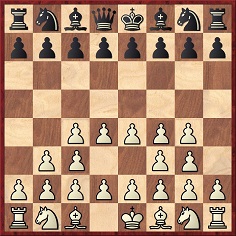
1 e5 e6 2 d5 d6 3 e4 c6 4 exd6 cxd5 5 e5 b6 6 d4 f6 7 Bd3 g6 8 Be3 Nc6 9 c5 Bg7 10 b4 Bd7 11 b5 bxc5 12 bxc6 Bxc6 13 dxc5 fxe5 14 fxe5 Bxe5 15 Nd2 Rb8 16 Rb1 Qf6 17 Ne2 Qg7 18 O-O g5 19 Nb3 h5 20 Bd4 hxg4 21 fxg4 Kd7 22 f4 Bxd4+ 23 Nbxd4 Nf6 24 f5 e5 25 Ne6 Rxh2 26 Nxg7 Nxg4 27 f6 e4 28 f7 Rbh8 29 f8(N)+ Kc8 30 d7+ Kb7 31 d8(N)+
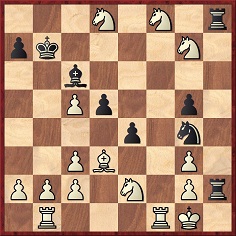
31...Ka8 and Black wins.
The Deutsche Schachzeitung adds a note on the mate-avoiding line 30 Nh7 R8xh7 31 Rf8+ Kb7 or Kd7 32 Kf1, allowing 33 Ng1.
The same magazine gives a number of games where White has eight pawns, in various initial formations, for the queen: 1849, pages 189-190, 1850, pages 21-24 and 1850, pages 153-160.
(1274)
Lionel Kieseritzky (1806-53) deserves to be remembered for more than losing the ‘Immortal Game’. The encounter below, played at unusual odds, illustrates his ingenuity and demonstrates that, contrary to what is often supposed, such concepts as play against a backward pawn were not unknown a century and a half ago.
Lionel Kieseritzky – Lecrivain
Paris, 1842
(Remove White’s rook at al and add extra white pawns at c4, d4 and f4.)
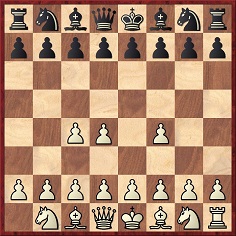
1 e4 e6 2 d5 d6 3 d4 f6 4 dxe6 Bxe6 5 f5 Bd7 6 f4 Nh6 7 Qh5+ Nf7 8 Nf3 Qe7 9 Bd3 Nc6 10 c3 O-O-O 11 d5 Nb8 12 b4 c6 13 Be3 b6 14 O-O Na6 15 Nd2 c5 16 b5 Nc7 17 a4 Nh6 18 Bf2 Rg8 19 a5 Qe8 20 Qh4 Nxb5 21 cxb5 Bxb5 22 c4 Bd7 23 axb6 axb6 24 Nb1 Kb7 25 Nc3 Ra8 26 Rb1 Ra3 27 Be1 Qa8 28 Qf2 g6 29 fxg6 hxg6 30 Qb2 Qa7 31 Nb5 Bxb5 32 Qxb5 Ra6 33 Ba5 Rxa5 34 Qc6+ Ka6 35 Nd4 Qb7

36 Qb5+ Rxb5 37 cxb5+ Ka5 38 Nc2 Ka4 39 Bc4 and White mates next move.
Source: Geistreiche Schachpartien by L. Bachmann (Ansbach, 1894), pages 54-55.
(2075)
To the Chess Notes main page.
To the Archives for other feature articles.
Copyright: Edward Winter. All rights reserved.